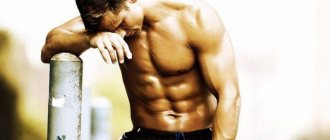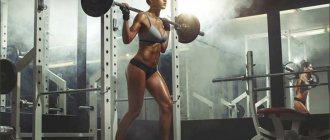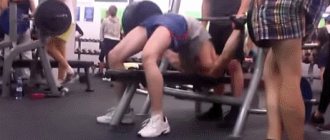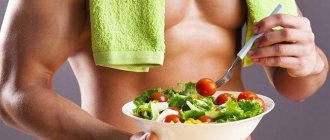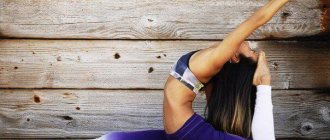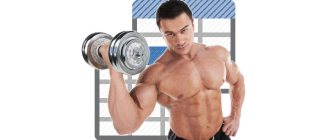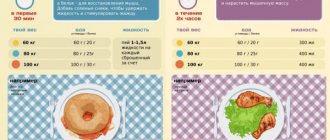Pain and muscles: everything you need to know about muscle pain
You have decided to go to the gym. Great! And you even attended your first training session and gave 100 percent. And then the next morning you literally cannot get out of bed: all your muscles hurt. Moreover, muscle pain occurs not only among beginners, but also among experienced athletes, for whom training is an integral part of life. For some, muscle pain is a sign that physical activity was necessary. But sometimes there is such a condition that it is impossible to go down the stairs, let alone exercise. Don't let muscle pain distract you from your training process.
We have prepared for you some facts from fitness experts, thanks to which you will learn why muscles really hurt and how to minimize the discomfort from painful sensations.
Pain is a natural physiological response to exercise
Instagram: @maxokun / Via instagram.com
This tense, painful feeling you experience after exercise is what doctors call “delayed muscle soreness,” or soreness.
“The skeletal muscle—the thing you work on during exercise—swells a little, so it becomes stiff and tender to the touch. As a result, there is a temporary decrease in muscle strength,” says Harry Pino, Ph.D., a practicing exercise physiologist in New York City.
This is a completely normal part of your body's healing and repair process. Lingering muscle pain is especially common among beginners who are not used to intense, high-repetition exercise. But in reality, anyone can experience it, regardless of fitness level.
It is a misconception that pain is caused by lactic acid.
thinkstockphotos.com / thinkstockphotos.com
A fairly common myth is that post-workout pain occurs due to the accumulation of lactic acid in the muscles. But about 10 years ago it was dispelled. “Lactic acid is a consequence of exercise, but it burns and disappears from the body within 5 hours,” says Tony Gentilcore.
It is very important to understand that pain does not arise from lactic acid, but from the process of repairing microdamage to muscle tissue. “Otherwise, people will continue to go to the gym and sooner or later they will get injured,” says Harry Pino.
Chest discomfort after yoga
Yoga is a type of gymnastics that has contraindications. Before the first workout, you need to examine the spine, myocardial functions, monitor the level of arterial and intracranial pressure, and consult with a neurologist.
More often after yoga, pain and discomfort occurs in the chest due to:
- consequences of stress;
- vertebrological disorders;
- cardiovascular and neurological diseases.
But doctors believe that the main cause of cardiac symptoms is an incorrectly compiled assan complex and training plan. Due to technically incorrect performance of yoga exercises, the heart and/or chest muscles hurt after training.
There is no need to use analgesics if the pain is not very severe
The advent of over-the-counter pain relievers may seem like a quick fix. But according to Dr. Pino, post-workout pain is more of a manageable discomfort. Both experts recommend not taking analgesics on a regular basis when you're experiencing normal muscle soreness. Research has shown that nonsteroidal anti-inflammatory drugs (NSAIDs) can affect skeletal muscle development.
And of course, you just don't want to exercise to the point of soreness that you need to take medication. But if you still experience sharp muscle pain, Pino advises giving preference to long-acting painkillers. The main thing is not to make it a habit.
After an intense workout, muscles usually feel sore for 12-72 hours
Pokémon/retrogamerblog.com
This is why you may feel like an absolute champion immediately after finishing your workout, but the next morning you won't even be able to get out of bed. “Post-exercise pain typically peaks around 24 to 48 hours after exercise and resolves within 3 to 5 days,” says exercise physiologist Harry Pino. So, even if you feel like you'll never be able to walk again, don't worry. Your condition will return to normal in about 72 hours.
see also
Tips on how to avoid back and neck pain when driving for a long time
The degree of pain depends on the duration and intensity of the workout.
amazon.in
As a general rule, the harder and longer the workout, the more likely it is that your muscles will become sore,” says Pino. At the same time, pain may occur if you start working with a new group of muscles that are already unaccustomed to physical activity. Therefore, you need to start a new training plan slowly and gradually, no matter if you are a beginner or an experienced athlete.
“Over time, your body will begin to adapt and become stronger, so your muscles will hurt less with certain exercises. But every time you increase the intensity of your exercise, your body will naturally respond with overexertion and pain,” says Tony Gentilcore.
How to reduce pain after exercise
To reduce pain, you must resort to the following methods:
- Massage . It allows you to disperse blood throughout the body and ensure the flow of nutrients to the right areas.
- A restorative activity. This workout involves using 50% of normal working weights with 15-20 repetitions per set, which provides blood flow to the muscles. They receive nutrients and recover faster. The point of such exercises is not only to reduce pain, but also to repeat the technique of movements, honing your skills.
- Cool down. By stretching the muscles, blood flow increases, which increases and accelerates the process of removing damaged cells, and, consequently, reduces pain.
- Proper nutrition. The diet must contain a lot of protein, the amount of which ranges from 2 to 2.5 g per 1 kg of body weight. To prevent catabolism and obtain simple amino acids, you should take BCAA. This also applies to glutamine, which also strengthens the immune system, which helps accelerate the full recovery of the body. Taking creatine can increase endurance and strength of muscle tissue by increasing the concentration of creatine phosphate.
- Have a good rest . If there is pain that prevents you from exercising, you should take a break for 2-5 days. This will allow you to fully recover and start exercising with renewed vigor.
Along with these methods, you can resort to hardening, visiting a bathhouse, sauna, using a warming ointment, and so on. These methods lead to improved blood circulation in damaged structures, which allows muscles to recover much faster.
Muscles will ache if you perform a new exercise at high intensity
Instagram: @eakinwale/instagram.com
If you have not done any exercise before, then the muscle groups it is aimed at are not sufficiently developed. As a result, other muscles will overcompensate for the load. According to Pino, running is the most common example. Many people start running in an unprepared physical state. “They often run incorrectly, their joints become overstrained and cannot handle the force of running,” Gentilcore says.
Typically, such a run will end with a shin injury or pain in the knees or hips - you can really hurt yourself. The same can be said about deep squats or deadlifts, which are performed by physically untrained people with heavy weights. “Find a competent trainer who can teach you proper technique before starting a new exercise,” advises Tony.
Causes of heart pain after strength training
Heart pain after intense training often appears in physically unprepared people and athletes involved in bodybuilding, kettlebell lifting or other weightlifting disciplines. The cause is considered to be injuries to soft tissues, the spine, or a lack of oxygen in the blood and impaired hemodynamics after abandoning cardio training.
Chest pain after chest exercises
The pectoral muscles hurt after training due to soreness, stretching or tearing of muscle fibers due to excessive stress. The discomfort goes away on its own after 1-3 days.
The chest hurts for a long time when a nerve or intercostal muscle is pinched. A simple set of actions will help in this situation.
- Exhale completely.
- Take a half-bent position: chin to chest, shoulders forward, upper body hunched.
- Raise your shoulders up and take a deep breath.
- At the same time, exhale and roll your shoulders back, straighten your back, and bring your shoulder blades together.
If your chest hurts from a cramp, then you immediately need to stretch these muscles with Rader rows or dumbbell flyes. To prevent muscle spasms, this cool-down should be done after the parallel bars and bench press between sets.
Pain in the pectoral muscles after training other parts of the body
The chest also hurts after exercise involving the muscles of the back or shoulder girdle. The cause is considered to be pinched nerve or soft tissue and the transmission of impulses from the nervous system. In this situation, it is necessary to warm up those muscles, after training which discomfort appeared.
Working on your technique and posture can help reduce soreness.
Belchonock / Getty Images / thinkstockphotos.com|Women|96580|Gender/f=CPIHVX/p=5/s=DynamicRank
According to Tony, many people think their back hurts from deadlifting. But in reality, it's not the weights they're lifting, it's the poor posture that puts strain on their joints. Conversely, even bodyweight exercises, such as squats or planks, can be hard on your back if done incorrectly.
So, you may think that you just need to stretch more to get rid of post-workout pain, when in fact it comes down to exercise technique and your posture.
Pain is not an indicator of a good workout
Instagram: @gymlovelife_fitcouple / instagram.com
When you hear the phrase “No pain, no gain,” you don’t have to take it literally. We have already said that muscle pain is normal when increasing muscle mass, and this cannot be avoided. But this is not what you should strive for. “Many people believe that pain is an indicator of serious training, but this is a dangerous mindset,” says Gentilcore. Experts warn that this type of thinking can lead to overtraining and you'll end up missing days or even weeks of training.
“If you don't feel any pain after exercising, you can increase the intensity of your exercise, but do it gradually so you don't hurt yourself,” recommends Pino. “And as soon as you start to feel pain, reduce the intensity a little to give your body a rest.”
Are muscles sore after workouts a good or bad sign?
Muscle pain is an optional sign of muscle mass gain, but they confirm that when performing training, muscle structures are destroyed and microscopic injuries are formed, which means that the process of healing and the formation of new structural tissue begins.
The success of training is not measured by pain. The absence of this feeling does not mean that the lesson was unsuccessful. Contreras and Schoenfeld, American researchers on the process, say that experiencing post-workout pain is not always a sign that muscles are growing.
The main goal of each training should not be to experience pain, but to progress the loads received. The effectiveness of exercise is indicated not by pain, but by an increase in the girth and volume of the muscles, as well as a comparison of the physique before the start of exercise and after training.
The best cure for sore muscles is active recovery
Instagram: @dogplaygram / Via instagram.com
"The best thing you can do to minimize the discomfort of muscle pain is active recovery," says Harry Pino. Rest between workouts is undoubtedly important. But to reduce muscle pain, it is not enough to just lie on the bed and wait for everything to go away.
Perform light exercises for 20-30 minutes - this load will stimulate blood flow in the muscles that hurt. Active recovery involves doing anything that mimics your normal exercise routine, but at a much lower intensity. For example, slow movements on an elliptical or exercise bike, brisk walking, circuit training or exercises with light weights. And no intense training.
How to prevent post-workout pain
It is almost impossible not to feel muscle pain completely. As training increases, it becomes less pronounced. There are several important points that allow you to exercise effectively, but feel extremely pleasant, but not aching or breaking pain:
- The loads must progress . Thus, only a small amount of weight is added to the resistance each week. If you perform a bench press with a barbell, then the optimal increase will be from 2.5 to 5 kg every week. After increasing the weight, you should master the execution technique, maintain a given number of sets and approaches, and then start adding weights.
- The technique must be mastered to perfection. You can contact a trainer or someone knowledgeable. If this is not possible, then you can always find information on how to do this or that exercise.
- Be sure to do a warm-up. It is an integral part of the beginning of training, includes a full range of movements for the whole body, as well as preparation for the upcoming training. If you do the bench press, then perform 2 to 3 warm-up sets with light weights and a small number of repetitions. This will ensure a rush of blood to the muscles and establish communication with the nervous system.
- Don't train when tired. A large amount of work, lack of sleep, bad mood and inability to eat well during the day are a good reason to refuse training so as not to expose your body to additional stress.
- Maintain drinking regime. During class you need to drink at least a liter of water. The daily norm of fluid intake is 0.04-0.05*own weight. Thanks to water, the blood does not thicken, the delivery of oxygen and nutrients is accelerated, and the passage of nerve impulses to muscle tissue is improved.
- Try to sleep well. It is best to get at least 8 hours of sleep.
Don't forget to drink water and eat right
gifer.com
“Sleep and water are two important recovery strategies that people often overlook,” says Gentilcore. In addition to resting and drinking enough water, make sure to eat well to replenish your electrolytes. Pino points out that “protein helps repair micro-tears in the muscles, and potassium is essential for muscle contraction.”
A cold compress or bath will also help soothe sore muscles for the first 12 hours.
thinkstockphotos.com / thinkstockphotos.com
“If you're feeling sore after a workout, there's a 12-hour window when ice packs or a cold bath at 7 to 10 degrees can help. Such procedures will calm the muscles and reduce swelling,” says Harry Pino.
Just don't put the ice pack directly on your skin - wrap it in a towel. After such cooling, Pitot advises warming up a little with a bath or wrap. But it is important to remember that ice and heat only help you feel better, they do not speed up the process of repairing the microdamage that causes pain.
Types of muscle pain
When considering whether your muscles should hurt after each workout, you need to understand that on a physical level, different types of muscle pain are different. Some of them indicate the accumulation of lactic acid, others indicate microtears in muscle tissue. And sometimes muscle pain can be caused by a serious injury.
| Type of muscle pain | What causes? | Effect on the body | How to relieve pain? |
| Post-training | A new type of training. Usually accompanies a pumping style of work. | Under the influence of the training complex, a large amount of lactic acid accumulates in the muscles, which does not interfere with, but does not help the anabolic processes. | Exceptional contrast shower. A relaxing or sports massage is available. |
| Lagging | Causes high-intensity strength training, or a sharp change in the exercise program. | Indicates microtears in the muscles, which, under the influence of adaptation and anabolic processes in the body, will lead to myofibrillar hypertrophy. | If you don't have a fever, a shower and a small amount of caffeine will help. Warming up the next day can also help. |
| Overtraining | Excessive stress from which the body cannot recover. | Under the influence of stress, more extensive damage to muscle tissue occurs, which is filled with lactic acid. Typically, such pain is more long-term in nature and indicates that your process will be slowed down for some time. | Exclusively painkillers. It is possible to use paracetamol at fever, or ibuprofen in its absence |
| Traumatic | Sprains, dislocations, impacts - muscle tears under the influence of excessively heavy loads. | A muscle tear is an injury similar to a fracture. Immediate consultation with a doctor is recommended. | Strong painkillers and a trip to the doctor to treat the damaged area. |
| Training | Pumping work, dropsets, supersets, and any other high-intensity long-term load. | During the pumping process, a huge amount of lactic acid enters the muscle tissue, which, thanks to the blood pump, remains there until the end of the approach. | Contrast shower and massage. |
| Aerobic | Any aerobic exercise. | If this is not heart pain, then the reason is severe fatigue of muscle tissue, which is simply unable to contract further. Usually does not affect long-term results, but it is recommended to reduce the intensity. | Anti-inflammatory drugs + sports nutrition for weight loss, for example, creatine - which reduces pain from aerobic exercise. |
Don't rely on cooling ointments - they are of little use
FOX/
“Ointments provide surface heating or cooling,” says Gentilcore. You may feel better. But, in fact, such means have no real effect. Tony advises avoiding excessive use of ointments, which can only cause harm. “You have used the ointment and already feel that the muscles seem to be fine. You run to do some stretching and an intense workout. A moment - and the muscles are overstrained again,” explains Pino.
Only time and active recovery effectively treat muscle pain.
Heart pain during athletics training
Chest pain may appear during running, shaping, performing cardio training, other types of athletics disciplines, or after exercise.
Their causes are:
- hemodynamic disturbances due to atherosclerosis of the coronary vessels;
- lack of oxygen due to a sudden and intense start to exercise;
- deficiency of magnesium and other beneficial substances;
- pathologies of the heart, stomach, intestines;
- neuralgia;
- oncological diseases.
If heart pain or discomfort occurs, you should immediately stop the load, switch to smooth movements and restore breathing.

